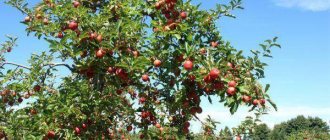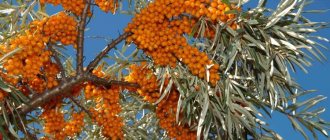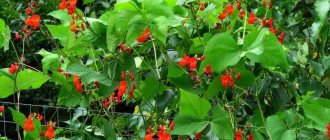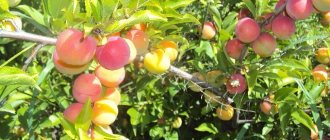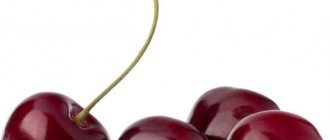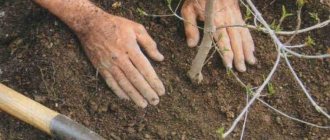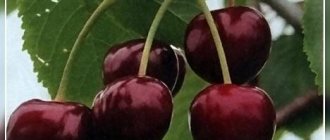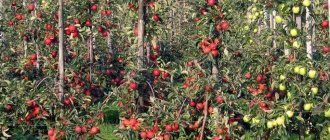Popular types and varieties of blackberries
There are several varieties of blackberries.
In our country, two of them are most famous: Bushy blackberry (Rubus fruticosus) and Gray blackberry (Rubus caesius). The first is sometimes simply called kumanika, the second variety in Ukrainian regions is usually called ozhina, and in the Caucasian republics - azhina. In addition, there are other types of fruit and berry bushes:
- Giant, or Armenian (Rubus armeniacus);
- Common (Rubus vulgaris);
- Blackberry (Rubus plicatus).
Garden blackberries are the result of many years of work by breeders. They crossed the plant varieties listed above to obtain varieties with the best characteristics. Today's hybrids are difficult to classify because they combine several features: erect and with thorns; creeping and thornless; erect and without thorns; creeping and winter-hardy, etc. And if you also take into account the ripening period of the fruits and their sizes... There are many options.
Therefore, we divided blackberry varieties according to ripening time. With over 200 varieties, you can choose from early, mid and late varieties to grow in your garden. The table shows only a few popular hybrids.
Name of variety Features Ripening period of berries Size of berries Natchez Semi-creeping shrub with powerful, thick thornless shoots up to seven meters in length. The berries are formed on the vines of the previous year. The variety is large-fruited, with pleasant-tasting berries
However, it does not tolerate drought and, most importantly, even moderate frosts. You will have to cover it for the winter even in the southern regions.
From June and throughout the month Up to 4 cm and up to 10 grams Karaka Black This is a variety with creeping lashes up to five meters long
The bush is not too spreading, the shoots are flexible, strong with numerous thorns.
The hybrid is high-yielding, unpretentious in care. However, it does not tolerate dry summers and frosty winters. Requires mandatory shelter during the cold season.
June-July (depending on the region) Up to 17 grams (on mature plants) Brzezina Blackberry Brzezina is the newest Polish variety, actively cultivated only since 2015. A powerful, erect bush with thornless shoots begins to bear fruit in the 3rd or 4th year. It is declared as winter-hardy, but domestic gardeners claim that it is still necessary to cover the bush for the winter.
June-July (depending on the region) Up to 12 grams (on adult bushes) Polar A standing bush with powerful thornless lashes up to two and a half meters long. The berries are large, with high tasting marks. The shoots tolerate even severe frosts well, but the flower buds can freeze. So it’s better to cover the bushes for the winter.
In the second half of July Up to 11 grams Loch Ness A very popular English variety. The bushes are semi-erect, with long shoots devoid of thorns. Berries with an average tasting rating, suitable for processing. A very productive variety!
Plants are unpretentious to soil and humidity levels. Average frost resistance - you don’t need to cover it for the winter only in the southern regions of Russia.
From mid-July Up to 10 grams (in young plants) Waldo Compact bushes with creeping shoots are completely devoid of thorns. The plant bears fruit already in the second year after planting in the ground and is highly productive. The berries are delicious. The variety has average winter hardiness. In regions with a harsh climate, bushes must be covered for the winter.
From mid-July Up to 8 grams Thornfree The American variety has been cultivated for several decades. The bushes are compact, erect, without thorns. A very high-yielding variety, the taste of the berries is average.
The plant is resistant to drought, but may not survive frost. It is still better to cover the bushes for the winter, although this is a tedious task due to the thick shoots.
From the end of August Up to 5-6 grams Navajo Another variety originally from the USA. The bush is erect, spreading, with long vines. The berries are not too large, but there are a lot of them on the branches. It is undemanding to humidity and soil, and has average winter hardiness. In all regions except the south of Russia, shrubs should be covered for the winter.
August-September Up to 7 grams of Kiova Low upright growing shrubs densely strewn with thorns. This is perhaps the only drawback. The berries are very large with a pleasant taste and aroma. Frost resistance is average - the bushes can withstand cold temperatures down to -23. It is recommended to cover the plants for the winter.
Beginning of August Up to 20 grams (there is evidence that up to 27 grams)
Selection of early blackberry species for the Urals
Early blackberries, which are used for growing in the Urals, ripen in July. The fruits do not ripen immediately, but evenly. The collection is collected within 1.5 months. Early species are creeping, erect, thornless and spiny. Their main disadvantage is reduced frost resistance.
The best varieties of blackberries:
- Natchez;
- Ouachita;
- Giant;
- Columbia Star;
- Čačanska Bestrna;
- Osage.
Natchez is a large-fruited, thornless variety. The weight of the berry can reach 10 g. It is characterized by semi-erect shoots reaching a height of 2-3 m. The berries have a sweet, slightly astringent taste. From 1 bush you can collect 16 kg of fruit. The plant can withstand frosts down to -15°C, so in winter it must be covered.
Ouachita is an early variety of blackberry that does not have thorns. The bushes grow massive, reaching a height of 3 m. The fruits are small - 5-6 g. Up to 25 kg of berries are harvested from 1 bush. The plant freezes at low temperatures. It is difficult to cover it, because the bush bends down with difficulty.
The giant is a subshrub that is completely covered with thorns and has climbing trunks. The berries are large or medium in size - 6-11 g, they are dense and have a pleasant taste. The variety is characterized by low frost resistance and winters well under cover.
Columbia Star is a variety that has long shoots growing up to 5 m. Because of this, it is quite difficult to care for the plant. The bush produces a good harvest, and the berries vary in size. Such blackberries are not afraid of drought and heat, but they do not tolerate frost.
Chachanska Bestrna is a variety that allows you to collect up to 15 kg of berries from a bush. The bush has no thorns, making it easy to collect fruits. The berries are large, juicy, sweet and sour in taste. Characterized by a short shelf life. The plant is undemanding, tolerates drought and heat well, and occasionally gets sick.
Osage is a variety whose berries have the most unique taste. But it differs in its low yield - 3-4 kg of fruits are harvested from 1 bush. The bushes grow vertically, reaching a height of 2 m. The shoots have no thorns. The shape of the berries is oval-round, the fruits themselves are small in size. The plant does not tolerate frost, so it must be covered when winter comes.
Caring for blackberries in the Urals
Blackberry care for the Urals should be complete and of high quality. To get a rich harvest, it is recommended to loosen the soil regularly. This prevents stagnation of water, and the root system is well saturated with oxygen. Do this once every 2 weeks. In the first 2-3 years, the bushes are not fed. After this, nitrogen-based fertilizing begins. If the soil is not very fertile, in the spring it is fertilized with humus or compost.
In the autumn, superphosphate and potassium supplements that do not contain chlorine are used. Blackberries can be sprayed with 1% Bordeaux mixture, which prevents the proliferation of microorganisms. As an additional disease prevention, the soil under the bushes is cleared of fallen leaves.
The bushes need to be watered regularly, in moderation. The soil should not be allowed to dry out, but it is also prohibited to overwater the bushes. 2 months after planting, watering is gradually reduced. When the berries begin to ripen, water the plant once a week using 2 buckets of water.
From the second year, the stems are shortened to 1.5 m in the spring, as a result of which the plant begins to bloom luxuriantly and produces a good harvest. In early June, when a large number of shoots appear, the bushes are thinned out. The youngest shoots are removed, leaving the strongest ones.
Autumn care includes basic pruning of an adult plant. All branches that bear fruit are removed from it. It is recommended to leave only 5-7 shoots of the current year on the bush. The next season they begin to bear fruit. The bush is pruned again in the spring, getting rid of weak and damaged stems.
Caring for blackberries in the Urals
Blackberry care for the Urals should be complete and of high quality. To get a rich harvest, it is recommended to loosen the soil regularly. This prevents stagnation of water, and the root system is well saturated with oxygen. Do this once every 2 weeks. In the first 2-3 years, the bushes are not fed. After this, nitrogen-based fertilizing begins. If the soil is not very fertile, in the spring it is fertilized with humus or compost.
In the autumn, superphosphate and potassium supplements that do not contain chlorine are used. Blackberries can be sprayed with 1% Bordeaux mixture, which prevents the proliferation of microorganisms. As an additional disease prevention, the soil under the bushes is cleared of fallen leaves.
The bushes need to be watered regularly, in moderation. The soil should not be allowed to dry out, but it is also prohibited to overwater the bushes. 2 months after planting, watering is gradually reduced. When the berries begin to ripen, water the plant once a week using 2 buckets of water.
Blackberries are not pruned in the first year. You can cut off only the inflorescences, thanks to which it takes root well.
From the second year, the stems are shortened to 1.5 m in the spring, as a result of which the plant begins to bloom luxuriantly and produces a good harvest. In early June, when a large number of shoots appear, the bushes are thinned out. The youngest shoots are removed, leaving the strongest ones.
Autumn care includes basic pruning of an adult plant. All branches that bear fruit are removed from it. It is recommended to leave only 5-7 shoots of the current year on the bush. The next season they begin to bear fruit. The bush is pruned again in the spring, getting rid of weak and damaged stems.
How to care
Caring for blackberries grown in the Urals requires following some simple rules.
Loosening and watering
To obtain a secure harvest, you will have to frequently loosen the soil. Thanks to it, the water will not stagnate, and the roots will receive the required dose of oxygen. Watering should be constant, but moderate. It is important to prevent the soil from drying out, but standing water also has a detrimental effect on bushes.
On the video - how to properly care for:
Shaping bushes
Like raspberries, blackberries begin to produce their first fruits the following year. It is at this time that the bushes will need to be molded and tied up. The following options can be used as supports:
- Arched or fan . These products are to be installed in the middle of the bush. They will straighten the shoots upward and horizontally.
Flat trellises. All shoots will be laid on one side. In this case, the fruits on the young shoots can be seen in a year.
- Supports may be concentrated along the rows of bushes . This option is considered the most comfortable.
When molding, for the real growth of the bushes, it is necessary to separate the fruiting stems from the young and replacement shoots. And oh, this is how caring for garden blackberries happens, you can understand by looking at the contents of this article.
Trimming
In the first year of crop growth, it should not be pruned. The only thing you can touch is the inflorescences. This will allow the plants to take root firmly. The tips of the shoots, frozen after winter, must also be removed.
Already, starting from the second year, in the spring, cut the trunks to a length of 1.5 m. In this way, you can get lush flowering and increase productivity. In early summer, thin out bushes that have produced many shoots. You will have to cut out very young shoots, leaving the most powerful ones. It's also worth reading about whether blackberries need to be pruned.
Protection from diseases and pests
The blackberry has only recently “registered” in our gardens, and there is still no proven method of protection for this crop. Raspberries and blackberries have many common pests, so gardeners use schemes that have long been tested on raspberry plantations.
In the spring, a whole range of measures are carried out to protect blackberries from diseases and pests:
- For anthracnose, the drugs Chistoflor and Agrolekar are used.
- Tsineb and Euparen help with gray rot.
- Blackberry bushes are treated with Fitoverm, Actellik or Akarin against raspberry beetle and stem fly.
- The same Fitoverm is also used to protect plantings from spider mites.
Blackberry pests and diseases
Most often the crop is affected by fungal diseases. The main signs of fungal infections are spots on the leaves and stems.
Septoria blight (White spot) is most often caused by infected seedlings. The disease manifests itself in rainy times and appears on last year's shoots. Light brown spots appear on the leaves, gradually turning white. The plant stops growing, the berries become smaller, do not ripen and rot.
Affected shoots and leaves are cut off and destroyed.
To prevent the disease in the spring, before the buds open, spray the bushes with a 1% solution of Bordeaux mixture, Fitosporin M (5 drops per 1 liter of water).
At the first manifestations of the disease, the bushes are sprayed with Gamaira solution (1 tablet per 1 liter of water).
Anthracnose is a fungal disease in which the leaves along the edges and along the veins become covered with gray-violet spots, the branches dry out and die, and the fruits fall off.
To combat the disease, fungicides are used: Oxychom, copper oxychloride, Previkur, Fundazol. Treatments are carried out 3 times every 2 weeks.
Often the crop is affected by rust. Small velvety yellow dots appear on the leaves and stems, gradually turning into large spots. With significant damage, the leaves fly off and the shoots wither.
The following drugs help fight rust: Fitosporin, Topaz, Baktofit, solution of Bordeaux mixture (1%). Treatment requires 2 treatments with an interval of 7-10 days.
Pests of crops:
The Western May beetle damages the roots of the plant by gnawing them. During the flowering period, the pest feeds on leaves.
To protect against beetleworm, the roots of seedlings are soaked for 30-40 minutes in Aktara solution before planting.
When a beetle invades, the soil is treated with Antikhrushch and Konfidor.
Raspberry beetle - damages leaves, inflorescences, stems, roots. The beetles overwinter in the soil and come out in the spring. They gnaw holes on flowers and berries. Rot forms in the affected areas.
For prevention, the soil is dusted with tobacco dust or wood ash.
7-10 days before the flowers bloom, spray the bushes with solutions of Actellik, Iskra, Kemifos.
Spider mite - lives on the outside of leaves, forming a web. It feeds on the juice of all vegetative parts of the plant.
When damaged by mites, plants are treated with Fitoverm, Actofit, Bi-58.
Number of treatments: 3 times every 7 days.
Where to plant blackberries on the site
In cold regions, it is better to plant blackberries along a solid fence that will protect them from the north wind.
In the Moscow region and other regions where the warm season is short and the winter is long, blackberry bushes are placed in light, sun-warmed areas. It is desirable that there be protection from the prevailing winds in the form of buildings, trees or folds of terrain.
Like grapes, you can plant blackberries near the southern wall of the house or near the fence, retreating at least 1 m. Closed basins with stagnant cold air, as well as hilltops from which snow is blown, are not suitable for plants. Snowdrifts are the best protection for bent bushes from winter frosts.
- Wetlands are not suitable for blackberries. Dampness provokes excessive growth of shoots and slows down their ripening, greatly reducing winter hardiness. It is advisable that groundwater does not come closer than 1.5 m to the surface of the earth.
- But the plants tolerate soil drought better than raspberries, but at the same time they respond well to moderate moisture in the root area.
- To the south of the Middle Zone, it is recommended to plant blackberries in such a way that during the day the bushes are in slight shade. This will save the berries from damage in the sun. As for northern gardens, only the most winter-hardy varieties (Agavam, Flint, Ufimskaya local) can successfully grow and bear fruit in partial shade.
Closed ground
Greenhouse conditions make it possible to grow large-fruited blackberry varieties with high consumer qualities.
In an effort to grow late-ripening varieties of blackberries in the Moscow region or in Siberia, gardeners sometimes build greenhouses for plants that can extend the growing season. Modern materials (agrofibre, polycarbonate) allow the construction of protective structures without much hassle.
It is only necessary to provide for the possibility of opening the greenhouse in the summer, otherwise the leaves, flowers and berries will overheat. The roof of the structure is made removable or sliding so that the snow covers the bushes in winter. Roots and branches must overwinter under snow, otherwise they will freeze. The root system of blackberries is less winter-hardy than that of raspberries.
How to plant blackberries correctly
For blackberries, it is best to dig trenches because the seedlings do best in shallow depths. Blackberries are planted as follows:
- in a selected location (for example, along a fence or supporting wall), dig a trench approximately 30-50 cm deep. Its length depends on the number of seedlings;
- organic fertilizer (peat, compost or humus) is poured into the trench so that approximately half of the furrow is filled;
- Considering that blackberries grow strongly, the distance between seedlings should be left at least 2 m, the roots of this plant prefer to feel free;
- Immediately before planting blackberry bushes, the trench should be thoroughly watered with warm water so that the seedlings take root faster.
If you plant your plants in several rows, then the width between the trenches must be at least 2 - 2.5 meters, otherwise you simply will not be able to get through the thorny overgrown bushes.
You can mulch the soil with peat or simply cover the roots with film for better adaptation - this increases the temperature in the soil and helps the seedlings take root. The roots of young blackberries are quite tender.
You should not plant blackberries on a hot day; choose cloudy weather, and it is advisable to shade the bushes until they finally begin to grow. After this, all covers can be removed and you can continue caring for your berries in the open ground.
How to plant and grow crops
Growing blackberries in harsh climates is not so easy, but if you follow the requirements of agricultural technology and careful care, they reward you with berries rich in useful components.
Dates suitable for planting
In Europe and America, where blackberries are cultivated on an industrial scale, there is not much difference when plant shoots are sent into the ground - in spring or autumn, but this period determines whether the shrub will survive in a climate with cold winters and late frosts. To eliminate the risk of blackberries dying in the Urals and Siberia, they are planted in the first ten days of May or from September 1 to 15. In this case, there is a higher probability that the plant will not only survive, but will also be able to take root.
Where to plant on the site
The place for blackberries should be well lit by the sun and inaccessible to northern winds. The subshrub feels comfortable at a distance of a meter along a hedge or fence on the western or southern side. Blackberries need fertile soil, not rocks, salt marshes or swamps. The crop dies when the roots reach groundwater.
Pre-planting work
Having chosen a suitable place for the plant, the entire area is cleared of weeds, the remains of stems are removed, and the soil is carefully dug up.
Site preparation
Since blackberries are demanding on soil fertility, before planting the soil must be fertilized with organic matter and mineral complexes.
For 1 sq. m of area contribute:
- a bucket of humus;
- 2 tbsp. spoons of potassium sulfate;
- 100 g superphosphate.
10–15 days before planting blackberries, deep holes with a diameter of 40–50 cm are dug in a plot of several rows, leaving a distance of 1.5 m between each.
Preparation of planting material
The bushes of the crop, which are preferably purchased from a nursery, are soaked in water, where they must remain for at least half a day.
Procedure technology
The seedling is placed vertically in the hole, deepening the neck by 2 or 3 cm, the roots are placed on a mound made in the hole. After this, a ditch is dug around the bush, half a bucket of water is poured, and the ground near the plant is mulched with peat. The shoots are trimmed, leaving branches up to 5 cm long.
Care
Planting and caring for grapes can present certain difficulties for beginners. Here it would be wise to turn to the practices of experienced winegrowers, following the advice presented below.
Trellis device
In the conditions of the Urals, for good development of grapes, a trellis is required. On it, the vines are better warmed by the sun and are more convenient to care for. The trellis can be vertical or two-plane. In the first case, vertical posts made of wood or metal, about 170 cm high, dug in on both sides of the grapes, are used for support. A wire is stretched between them, the first row of which is located at a distance of about half a meter from the surface of the earth, and all subsequent rows are 40-45 cm apart from each other.
Double-plane trellises are used for growing frost-resistant, vigorous grape varieties. They consist of two vertical crossbars connected to each other. The trellises are arranged in advance, even before the seedlings are planted. Since if you build a support after, there is a risk of damaging the root system of the grapes. If wooden beams, rather than metal pipes, are used for the structure, you need to choose hardwood.
Fertilizer
As a top dressing, humus or peat is applied under the bushes in the spring. You can also use specialized fertilizers for grapes. The first three years after planting, the grapes are not fertilized; they have enough nutrients that are released from humus and peat, as well as mineral mixtures initially placed in the planting hole.
In the fourth year, fertilizing is carried out before the beginning of the growing season, during fruit set, and before covering the vine for the winter.
Watering
Caring for grapes in the summer in the Urals consists of watering, loosening, pruning, and treating them against pests. The vineyard is watered twice a year: in May, before flowering begins, and then during berry set. After irrigation, the soil under the bushes is loosened and mulched with peat and straw. Mulch will not allow weeds to grow, will keep the soil moist, and when decomposed will provide nutrition to the grape roots.
Important! For a good harvest on young shoots, it is necessary to remove the stepsons
Trimming and shaping
In the first year, the grapes are not pruned, but only pinched.
In subsequent years:
- At the beginning of June, dried branches are removed.
- In mid-summer, shoots are pinched for better growth.
- After harvesting, two fruiting branches are formed.
- Two shoots are left on the vine, the rest are pinched.
Thus, by autumn there should be four fruiting vines and two spare shoots at the base of the bush.
In Siberia and the Urals, grape bushes are formed using a standard-free method. Like a multi-armed fan or oblique cordon. Properly formed grapes are more winter-hardy and produce better yields.
Shelter for the winter
Cover the grapes according to the following scheme:
- Before wintering, the bushes are pruned.
- The vines are removed from the trellises and placed on the prepared flooring in a groove.
- To prevent fungal diseases, you can treat with 1% Bordeaux mixture, Fitosporin.
- A structure made of boards in the form of a hut is built over the ditch and covered with agrofibre or roofing felt.
- A layer of sawdust, spruce branches or straw is placed on the agrofibre as insulation.
- Cover with film or slate.
They remove the shelter at the end of April, focusing on the weather and the possibility of spring frosts. You need to open the grapes gradually so that they get used to the surrounding air.
Aftercare
If you take care of blackberries, even in harsh climates they will reward you with the first fruits. In order for the roots to be saturated with oxygen, you need to constantly loosen the soil throughout the entire area.
Irrigation
The first month or 2 after planting, the bushes need to be watered frequently. After the blackberries take root, the amount of moisture is reduced. But when the berries begin to ripen, once a week 2 buckets of water are poured under each bush.
Foliar and root fertilizer
In spring, blackberries need nitrogen, it is contained in urea. Every 2 years, a bucket of compost or humus is added under the bushes, and the stems and leaves are sprayed with Bordeaux mixture.
Support garter
Blackberries have very long shoots; after planting and pruning, they are fixed to the trellis:
The shoots are attached to the wire in the center, and the fruiting shoots are directed to the side, woven together in twos or allowed to trail down. Tying it to a support using any of these methods makes pruning easier and makes picking berries easier.
Formation
If the bush produces flowers in the first year, it is advisable to cut them off. The following spring, the branches are shortened by 15 centimeters. In the summer, fruit-bearing shoots are cut off completely and excess growth is removed.
Shelter for the winter
Even cold-resistant hybrid crop varieties in Siberia and the Urals often freeze out. To prevent this from happening, in the fall they dig a trench where young branches are laid and covered with pine needles and sawdust. In the spring, before the buds appear, the plant is freed from covering material.
Selection of the best blackberry varieties for the Urals
For regions with harsh climates, varieties are chosen that can withstand significant drops in temperature and strong winds. When choosing a variety, great importance is paid to the period of fruit ripening. The harvest must have time to ripen before the onset of cold weather.
There are many varieties of blackberries that grow and bear fruit well in unfavorable climates. They are divided into several categories.
Thornless varieties
Blackberry varieties with a complete absence of thorns on the stems, which create many difficulties when growing the plant, are very convenient for harvesting.
The Loch Tay variety is a new very early variety, fruiting begins in June. A semi-creeping shrub, powerful shoots reach 3-4.5 m and require support. The variety is characterized by the absence of thorns. The light brown stems first grow upward, then bend. The leaves are dense, serrated, large, the flowers are white. The fruits are slightly elongated, large, weight 10-12 g, very sweet. The yield of 1 bush is 20-22 kg, the highest yields are achieved in the 4-5th year of bush growth.
The variety is valued for the following qualities:
- early fruit ripening;
- high yield rates;
- resistance to severe frosts and high temperatures (up to 40ᵒC);
- drought resistance,
- excellent taste, one of the sweetest varieties;
- possibility of industrial breeding;
- high resistance to diseases and pests;
- increased keeping quality;
- tolerates long-term transportation well.
Disadvantages of the variety
- requires regular pruning;
- short fruiting period, ending by the end of July;
- affected by rust.
Thornfree is one of the first thornless blackberry varieties. The bush has semi-creeping thick (3 cm) shoots 4-6 m long. The flowers are pink, the fruits are dark purple, weight 6-7 g. 30-60 berries ripen simultaneously on one cluster. 22 kg of fruits are collected from 1 bush. The harvest ripening period is extended - mid-August - late September.
The advantages of the variety include:
- ease of care;
- high yield rates;
- preservation of appearance during long-term transportation;
- good resistance to diseases and pests.
Disadvantages of the variety:
- subtle differences between degrees of maturity;
- The variety requires shelter in winter.
Polar is a shrubby vine with erect, powerful shoots growing to a height of 2.5 m and drooping branch tips. The flowers are white, black berries have a sweet taste with a slight sourness, the fruit weighs 10-11 g. A four-year-old bush produces 4.5-5 kg of berries. Can be grown on an industrial scale.
The variety is different:
- high productivity;
- the possibility of cleaning with mechanized equipment;
- When stored for a long time, overripe berries do not crack and juice does not flow out;
- the variety can withstand temperatures down to -25°C.
Disadvantages of the variety:
- shelter is required when the temperature drops more than 30ᵒC;
- powerful shoots are difficult to tilt towards the ground for shelter.
Winter-hardy varieties
Winter-hardy berry plants are more suitable for residents of the Urals. Most crops are hybrids and can tolerate temperatures down to -35°C.
Agavam - forms a powerful, compact bush with thick shoots with drooping tops. The branches are covered with brown sharp thorns. The bush produces a lot of growth. The weight of the fruit is 4-5 g, the taste is sweet and sour. 5-15 kg of berries are collected from each bush. Fruiting is extended, the bulk ripens in mid-August. The variety can withstand temperatures down to -25-30⁰ C.
Advantages of the variety:
- ease of care;
- good shade tolerance;
- does not require shelter for the winter;
- high yield
Disadvantages of the variety:
mediocre taste of overripe berries.
Darrow is a shrub with erect shoots and small thorns. The height of the lashes reaches 2.5–3 m; white flowers are collected in 8–12 pieces; berries are elongated, black, 2.5 cm long, weight 3-4 g; The pulp is juicy, sweet and sour. The yield of 1 young bush is 3.5-4 kg, every year the figures increase and reach 10 kg. The variety can withstand frosts down to -34ᵒC. Ripening lasts 1.5 months.
Blackberry varieties for Siberia
The Rubus genus is grown on an industrial scale in North America. In Russia, it is planted mainly by summer residents in the Leningrad region, and in the Moscow region, and in the Far East, and in the Crimea.
Blackberries take root and bear fruit in Siberia:
- Taylor;
- Agawam;
- Lawton;
- Thornfree.
The varieties are valued for their large berries and decorative appearance. All of them can withstand frost, but in harsh climates they take shelter for the winter.
Early
In Siberia, it is recommended to plant blackberries, which ripen not in September, when it is already cold, but in early summer. The Eldorado variety takes root in regions with harsh climates. Erect bushes have long shoots covered with large thorns. In early June, the Giant blackberries ripen. The fruit weighs only 7 g, but the plant produces a good harvest and is valued for its high winter hardiness.
One of the new early hybrids, Black Butte, is distinguished by large fruits; individual specimens weigh 20–23 grams. The oval berries of Agawam blackberries are harvested in several stages. The bushes of this variety are of medium height, thick shoots, falling down, dotted with brown thorns. The plant can withstand frosts down to -30 °C.
With an average ripening period
In temperate climates, the blackberry variety Tupi takes root. An erect bush with small thorns is rarely affected by diseases and can withstand frosts under cover. The harvest ripens by early August. The weight of one berry reaches 9–10 grams. The Lawton variety is distinguished by its rapid ripening; in a favorable year, a whole bucket of small blackberries is harvested from the bush.
Plants with long branches do not suffer from diseases, but they can tolerate frosts of -20 °C only under cover.
Late ripening
In regions where summers are short, varieties with early ripening are planted, but in the south of Siberia, Texas blackberries, bred by Michurin, are grown. In August, the creeping bushes ripen with aromatic, sour berries weighing about 10 grams, which can be canned and frozen.
See also
Description of blackberry variety Black Diamond and pros and cons, planting and careRead
Chokeberry blackberries must be covered for the winter. The harvest is harvested in the last month of summer and in September. One branch of the plant bears 15–17 small fruits.
Shade-tolerant
Blackberries take root in different conditions, but the taste of the berries deteriorates with a lack of light, in damp and rainy weather. The shrub loves the sun, but some varieties thrive in the shade. These include Agave, its advantages are called:
- exceptional frost resistance;
- high productivity;
- good berry taste.
The Thornless Evergreen variety grows in the shade. There are no thorns on the shoots of the plant. One cluster bears more than 60 small fruits.
Frost-resistant
Darrow blackberries adapt well to the cold winters of Siberia. An erect bush covered with thorns does not die at a temperature of -35 °C.
They have high frost resistance:
- El Dorado;
- Agawam;
- Snyder.
The American hybrid Thornfree pleases with large berries. A powerful plant with long shoots does not suffer from diseases and tolerates cold winters normally, but under cover.
Repairers
To increase the yield of blackberries, the bushes are thinned, leaving no more than 5 branches. In Siberia, where cold autumn quickly arrives, among the remontant varieties of plants, strewn with fruits, only a few take root - Black Magic and Ruben with large berries and good winter hardiness, as well as Prime Yang, adapted to unfavorable conditions.
How to choose the right variety
After the domestication of the wild perennial, in addition to the creeping variety of the plant, the erect blackberry was bred. But almost all varieties of subshrubs cannot withstand such frosts as raspberries, which belong to the same genus Rubus. In Siberia, where the air temperature drops to -40 °C, blackberries grow, but you need to plant varieties adapted to harsh climate conditions and take into account that you still have to cover the bushes.
For the Urals, where strong winds blow, preference should be given to erect, frost-resistant shrubs.
When is the best time to plant blackberries?
Blackberries can be planted both in spring and autumn. However, spring planting is considered preferable by gardeners: over the summer the shoot will have more time to take root well and gain strength for the future wintering. However, having planted a seedling in the fall, you can also be sure that next year’s blackberries will delight you with green leaves and the first flowers. Of course, provided that you have followed all the details of autumn planting.
Blackberries are a rare guest in summer cottages
Features of spring planting
Spring planting of blackberries is carried out before the buds begin to grow - this is the period from mid-April to early May. By that time the soil will be sufficiently warmed up, which will contribute to better survival of the seedlings. The planting site should be prepared in advance, preferably in the fall. To do this, a suitable area must be dug to the depth of a spade bayonet and organic and mineral fertilizers must be applied: per square meter of the area, take half a bucket of humus, potassium fertilizers (50 g) and superphosphate (100 g), sand or peat (0.5 g) should be added to the clay soil –1 bucket).
Subtleties of planting in autumn
In autumn, blackberries need to be planted a month before the onset of frost. Therefore, the optimal timing for this procedure will be (depending on the region) the end of August - the end of September. For autumn planting, you should choose plants in pots - they must be planted together with a lump of earth, so they will take root better
It is important to remember that blackberries do not tolerate low winter temperatures, which means there is a risk of immature seedlings freezing. To prevent it, it is recommended to trim the above-ground part of the bush to 30 cm.
And even the most frost-resistant variety should be covered and insulated for the winter.
A blackberry seedling purchased in a pot must be planted together with a lump of earth
Best time to transplant
The choice of season for replanting a bush depends on the type of blackberry. For example, thornless varieties of this berry are recommended to be replanted in the spring. This same season, as we said earlier, is much preferable for planting and replanting this crop. However, it is also not forbidden to carry out such work in September-October, especially if the autumn in your region is long and warm. The main thing is to carry out the autumn transplant at least two weeks before the onset of frost and do not forget to thoroughly cover the blackberries for the winter.
As for replanting in the summer, some gardeners also practice it. If you need to replant blackberries in the summer, follow these simple rules: carry out the procedure only in the early morning or late evening, when there is no active sun, and after replanting, water the bush thoroughly and create artificial shade for it.
Planting blackberries
Growing and caring for shrubs requires following certain rules. Only in this case will it be possible to get a rich harvest at the end of summer.
Blackberries are planted in open ground in the spring , when the soil has warmed up well. In regions with a warm climate, plants are planted in April, and in Siberia and the Urals in early or mid-May.
For shrubs, choose a place protected from the wind, well-lit with breathable, drained, loamy or sandy loam soil. The planting site must be prepared in the fall by adding fertilizer to poor soil. For one square meter of plot the following is added:
- humus, compost or manure - 10 kg;
- potassium sulfate – 25 g;
- superphosphate – 15 g.
Fruitful varieties of blackberries for the Moscow region and central Russia
Blackberries are gaining popularity as a berry crop due to the relative unpretentiousness and beneficial properties of the aromatic berries. If you follow the basic rules of agricultural technology, it gives an annual stable harvest.
Residents of the Moscow region and other regions with cold climates choose to grow on their plots those varieties that combine abundant fruiting and increased resistance to low winter temperatures. Thanks to the breeding work of American and European gardeners, such varieties have become available on the Russian market.
In the European part of the country, two main varieties are traditionally cultivated:
- 1. Gray blackberry (Rubus caesius), dewberry. It is a shrubby plant with long shoots that spread along the ground. The berries are covered with a bluish coating. This was the reason for the species name.
- 2. Bushy blackberry (Rubus fruticosus) or bramble. It grows as a bush up to 2 meters high. Like raspberries, it bears fruit on last year's shoots.
The first type often suffers from frosting of fruit buds. The second is more resistant to cold, but has lower yield.
Blackberries are among crops with average winter hardiness. Most representatives of the genus tolerate temperatures dropping to -17 and -19 degrees. The love of warmth explains the successful industrial cultivation of blackberries in the western American state of Oregon, a mild climate zone. Many new varieties and hybrid forms are bred taking into account the requirements for cold resistance. In selective selection, interspecific hybridization is used. The resulting hybrids are less susceptible to freezing and bear fruit more abundantly. Thornless blackberry forms have also appeared, making it easier to care for plantings. Varieties have been developed that have good resistance to diseases and pests.
From a wide variety (about 300 items), plants with different fruiting periods, size and number of berries are selected. Productivity per 1 sq. m of planting - 2 or 3 times more than in raspberry beds.
There is no variety that is ideal for all requirements. When choosing a blackberry plant for a personal plot, they choose those that combine two or more criteria: abundance, frost resistance, transportability, high taste.
The following varieties of blackberries are distinguished according to ripening time:
- early and very early produce the first ripe fruits already in early June;
- mid-season varieties begin to ripen from late June to early July;
- late ones produce a harvest until mid-August, some until frost.
Remontant varieties, in which the berry picking period is extended, have also become widespread. The fruits ripen in stages; regular harvesting is used every 2-4 days.
https://dachamechty.ru/ezhevika/na-urale-posadka-i-uhod.htmlhttps://nandatapew.ru/ezhevika-na-urale-posadka-i-uhod/https://naogorode.net/ezhevika- sorta-dlya-podmoskovya-urozhajnye/
Selection of frost-resistant blackberry species for the Urals
Frost-resistant blackberry varieties for the Urals tolerate low temperatures well. The following types are more popular:
Abundant is a variety characterized by massive shrubs without root suckers. Semi-creeping shoots are one hundred percent covered with spines curved inward. The fruits have an oblong shape and vary in small size. They taste sweet, with a slight sourness. This variety is excellent for the Urals, as it tolerates severe frosts well.
Ufimskaya is a variety with small berries weighing about 3 g. The fruits have a pleasant taste. The bushes are distinguished by their highest productivity - from 1 bush you can collect up to 12 kg of fruit.
Remontant varieties.
A very interesting variety - it produces two harvests, at the beginning of summer on overwintered shoots (June-July), and at the end of summer on young stems
IMPORTANT - for Siberian gardeners the variety may turn out to be unprofitable - the first berries may die from frost, and the later ones simply will not have time to ripen. Therefore, if you want to grow such varieties, get good greenhouses
"Prime Arc Freedom" is the newest variety with straight growth. It has no thorns. Large and very sweet. According to biologists, the yield is plentiful. But at the same time, the variety quickly dies in the cold season, so protection is mandatory.
"Ruben" is a hybrid variety. The bush is straight, vertical, and does not require support. Very impressive spikes! The first portion of berries appears in July, the second may well ripen until October. The fruits are large, the yield also does not disappoint. Well suited for temperate climates, does not tolerate cold below 16 degrees and heat above 30 degrees.
"Black Magic" is a low bush, growing up to 1.5 meters. It bears fruit in two sittings - at the end of June and at the end of August. The berries are predominantly large and sweet, the yield is average - from 5 kilograms per bush. Disadvantages - does not tolerate frost, and has thorns on the stems.
Blackberry propagation
It occurs in three ways: cuttings, layering, suckers.
- Cuttings are taken from the upper branches of the Blackberry in early summer. The cutting should consist of a stem, leaves and bud. The lower cut is processed by Kornevin and placed in soil made of sand and peat. After a month, the cutting will give roots.
- In spring, the top of the bush with shoots bends to the ground. The top with the shoots is buried in the ground, then when the shoot produces roots, cut it off from the older bush.
- Root shoots are also sprouting around the bushes. When they grow to 10 cm, they can be cut from the bush and planted in a new place. This happens in May-June, and before frost they have time to germinate and get stronger.
Conclusion
At the moment, the Blackberry culture is relatively young in our open spaces, but it is systematically winning the love of Russian summer residents.
The most important thing is to choose the right variety for your needs, soil and climate. Attentive attention to the plant will reward you with tasty large berries. Thank you for your attention!
If you are growing Blackberries or other plants that need staking, you may be interested in a special plant staking tool . Additional information can be read in the article “WHAT TAPENER-GARTER TO CHOOSE AND WHAT ARE THEIR DIFFERENCES”
Add a comment Cancel reply
You must be logged in to post a comment.
What care does blackberry require?
There is nothing complicated in caring for blackberries, you just need to remember a few mandatory rules:
- your berry needs frequent watering with warm water. Under no circumstances should you allow the soil to dry out or form a dry crust on the surface, which will impede the flow of air to the roots. This is especially true for young seedlings that were planted only this spring. For blackberries that have grown stronger and have been growing in one place for several years, underwatering is not so bad, but for young seedlings it can be simply disastrous;
- Overwatering is no less harmful to blackberries than underwatering, so do everything in moderation. If the days are hot, the plants should be watered at least twice a week so that the entire soil becomes moist. If the days are cloudy or it rains, watering should be reduced;
- Combine feeding your blackberries with watering. First, immediately after planting or just in the spring, when it is just beginning to grow, blackberries need to grow shoots. To do this, use nitrogen fertilizers, which precisely promote the growth of foliage. Sprinkle fertilizer granules directly on top of the soil along with watering. Fertilizers cannot be applied to dry soil, as they can burn the plants;
- As blackberries grow and berries appear, they need phosphate, which will produce more and larger berries. In addition, potassium fertilizers need to be applied throughout the season;
- after you have harvested the crop - this will happen at the end of summer, you need to start preparing the bush for winter. Now you need to add potassium fertilizers to the soil, and you should completely abandon nitrogen fertilizers - there is no need for the plant to grow shoots and leaves in the fall. And, of course, we must not forget about organic matter. You can simply mulch the beds with a thick layer immediately after you trim the berries.
However, we need to talk about pruning blackberries separately.
Features of planting and growing
To grow a crop and harvest a good harvest from it, it is necessary to provide it with quality care.
It is recommended to carry out planting work in early spring. This helps to avoid freezing of young crops.
Site selection and soil preparation
Blackberries need sunny areas
It is important to ensure that it is not exposed to wind or drafts. It is recommended to plant bushes near the fence
This will provide them with the support they need.
In spring, blackberries are planted in the spring, before the buds appear. To achieve good results, it is worth using fertile and drained soil. Loam or sandy soils are excellent options.
Acidity parameters are also important. For blackberries, the ideal pH value is 6-6.2
In conditions of high humidity, the bush will not be able to fully develop and will begin to lag in growth. This will negatively affect the future harvest.

